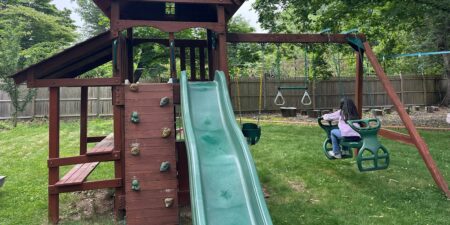Proponents of boosting the declining US birth rate are targeting Americans’ biggest expense: housing. They say what parents and would-be parents need are cheaper homes that would give their families the room and financial security to grow.
A recent report by the Institute for Family Studies, a conservative think tank that pushes for policies to increase the birth rate, concluded that housing costs were the single biggest factor stopping Americans from having as many kids as they want.
“Housing cost concerns are more influential on young adults’ plans than childcare costs, work schedules, job stability, student debt, healthcare access, paid leave, desire for leisure time, personal health, or other care obligations,” the report found. In IFS’ survey of more than 8,000 Americans 18-54 years old, a quarter of respondents listed housing costs as a concern, while 30% cited the cost of childcare, and 26% said they wanted more leisure time. But housing costs had the largest effect of those three factors on family size.
“Housing costs were unique in having a very large effect and being extremely common, so they explain the largest total amount of foreshortening of intentions,” Lyman Stone, the director of IFS’ Pronatalism Initiative and a co-author of the report, told Business Insider.
The group has an ally in Vice President JD Vance, who’s among the most prominent faces of the conservative push for more American babies.
“Our people aren’t having enough children to replace themselves. That should bother us,” Vance said in 2019. In his first speech as vice president, he told March for Life gatherers, “I want more babies in the United States of America.”
Are housing costs affecting your family planning decisions? Reach out to this reporter at [email protected]
Vance has been critical of subsidizing childcare and expanding parental leave; he favors policies designed to help parents who don’t work outside the home. The vice president has also called for building new housing on federal land that would be sold or leased to private developers, and supports cutting red tape, including land-use regulations, that limit housing construction.
He and his conservative allies could find common ground on housing with Democrats, who also believe the US needs to build many more homes to bring costs down. A White House spokesperson didn’t respond to BI’s request for comment.
When it comes to housing, conservative pro-natalists have slightly different aims than the typical YIMBY agenda, which focuses on building more dense housing in high-demand urban and inner-ring suburban areas, often around transit hubs. Groups like IFS want to prioritize building more single-family homes, which Americans tend to prefer over multifamily housing. An overwhelming majority of IFS survey respondents — 79% — said they preferred to live in a detached, single-family home, while just 59% live in that kind of home.
“There’s that desire to give your kids a backyard and have space to spread out when it comes to having and raising a family,” Brad Wilcox, a sociologist at the University of Virginia and the co-founder of IFS, told BI.
Wilcox said IFS has had conversations with the Trump administration’s Domestic Policy Council, and pointed to the administration’s efforts to sell federal land for housing construction as a promising path forward. The group also wants to see a slew of policy changes at the local, state, and federal levels to juice housing construction, including relaxing land-use regulations and legalizing more construction in undeveloped areas.
“For a lot of ordinary people, the most preferred and fruitful path to pursue here is to try to figure out ways to make affordable single-family housing more accessible to working middle-class Americans,” Wilcox said.
Replicating the baby boom
The US birth rate has been largely on the decline since the financial crisis of 2008. While many factors influence the choice to have kids, government policy is well-positioned to address the economic drivers.
There’s evidence that rising housing costs shrink family size. A 10% increase in home prices led to a 1% decrease in births among non-homeowners, economists Lisa Dettling and Melissa Schettini Kearney found in a 2012 paper published in the National Bureau of Economic Research.
The researchers also found evidence from the distant past that easier access to homeownership can help boost birth rates.
The advent of the modern, low-down-payment mortgage in the 1930s facilitated a sharp uptick in the US birth rate that helped create the baby boom, according to their February 2025 NBER working paper. The loans, backed by the Federal Housing Administration and the Veterans Administration, made it easier for some younger Americans to buy a home by allowing very low payments up front and 30 years to pay off the loans. (Black Americans were effectively excluded from these programs for years.)
The researchers found that the two mortgage insurance programs helped lower the age people got married and had their first baby, and led to 3 million additional births between 1935 and 1957, accounting for about 10% of the spike in births associated with the baby boom.
“Maybe how easy it is to have kids is less about can they take three months off work versus ‘do I have a bedroom to put this kid in for the next 18 years?'” Schettini Kearney, an economist at the University of Maryland, recently told BI.
Read the full article here
















